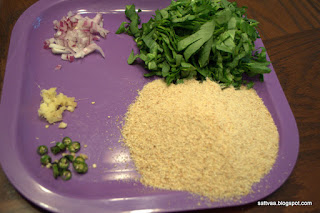For the uninitiated, gongura or sorrel leaves are green leaves with a tart taste, I have mainly seen the red stemmed versions of this leaf here but I hear there is a green stemmed variety also. Due to its inherent tart taste, these leaves impart a distinct flavor and go very well in recipes for chutneys and dals.
One of BH's atta's is an expert cook and her pachadis(chutneys/relishes) are very tasty, she follows a very traditional way of making the chutneys by hand grinding or pounding the ingredients in a big stone grinder (think much bigger version of mortar and pestle). It is also made with lot of oil for taste and for preserving. Typically this chutney is high on the spices loaded with hot red chilies and is mixed with hot rice and butter (according to my FIL) and eaten. This is a family favorite and like any chutney recipe, has its variations made to suit family's taste buds.
If you are in US, you can get these leaves in Indian groceries, farmers markets and Chinese stores. It typically starts to show up in mid to late Spring.
Here is a very low fat version of the yummy gongura pachadi.
What do you need to make Gongura Pachadi?
3 packed cups of gongura leaves (picked from the stems)
3 Tsp fenugreek seeds/methi seeds
2 Tsp white sesame seeds (optional but greatly recommended for flavor)
8-10 dry red chilies (I used only the milder Byadagi variety, if using spicier chilies like the Guntur variety, ease the number down)
1 Tsp cooking oil
1 Tblsp salt (adjust to taste)
1 Tbslp water for grinding
How do you make Gongura Pachadi?
- Wash gongura leaves in water, drain them and pat them dry.
- Heat a heavy bottom pan on medium heat and fry methi seeds until they turn light brown and start to pop. Keep them aside.
- Dry fry the chilies for 2-3 minutes until they crisp up and you see tiny brown spots on their skins. Keep aside.
- Dry fry the sesame seeds until they pop and keep aside.
- Add oil and drop the cleaned gongura leaves into the pan, fry until the leaves wilt completely and become a single mass (4-5 minutes).
- Take the red chilies, salt, methi seeds and half of the fried sesame seeds to your blender/grinder, make a dry powder.
- Add the gongura leaves and blend them together adding water only as needed.
- Add the remaining toasted sesame seeds and give it a whirl in your blender.
- Here is how we relished it - mixed it with hot cooked quinoa, a couple of drops oil and chopped onions with a side of Majjige huli. A bowlful of pachadi vanished in a single meal.
Notes:
- You need to balance the tartness of the leaves with a good proportion of red chilies and methi seeds, so the pachadi doesn't turn out primarily sour.
- Slow toast methi seeds until it turns light brown and red chilies become crisp for enhanced flavor, don't rush through the toasting process.
- I like the nutty flavor from the sesame seeds, keep a little portion to the last blend/grind cycle to have a few un-powdered seeds in the pachadi.
Tips:
- As amma knows my love for spicy food, she fries a couple of red chilies in a Tsp pf oil and pours it on top of the chutney so I can break them and mix it in for the extra punch. If you have people with different levels of spice tolerance, go mild on the chilies while making pachadi but use this trick to please that one person :-)

















































